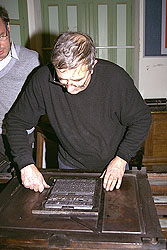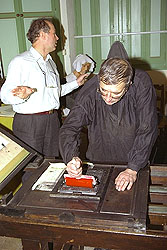 From Gutenberg to satellite telephony: Information technology ! From Gutenberg to satellite telephony: Information technology !De Gutenberg à la téléphonie par satellite: les technologies de l'information! |
We are photojournalists and we sell photos, and text features as a resource for online and off line magazine publishers.
Contacts: Phone in Santa Barbara: (805) 964 7059
Chief Editor: Jean-Claude Criton - news@presscom.com
|
to satellite telephony: Information technology ! |
à la téléphonie satellite: les technologies de l'information! |
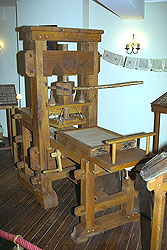 Une maquette grandeur nature de la Presse de T. Renaudot |
Jean Gensfleisch, dit Gutenberg. Orfèvre et imprimeur allemand (Mayence fin du XIVème siècle-1468). Gutenberg vécu notamment à Strasbourg où il se livre en secret à la fabrication de caractères mobiles (1438) et fait construire une presse à imprimer, puis à Mayence à partir de 1448 où il s'associe avec le banquier Johann Fust et un compagnon, Peter Schöffer. Il y imprime, entre autres, des lettres d'indulgence (1454) et une Bible dite à 42 lignes (1455) dont un exemplaire est conservé à la Bibliothèque Nationale. Evincé par ses associés en 1455 à la suite de difficultés financières, il se fixe à Bamberg où il imprime la célèbre Bible à 36 lignes (1457-1458). En 1465, l'archevêque de Mayence, Adolphe II de Nassau, l'anoblit et lui fournit le moyen de reprendre ses travaux d'imprimerie. Il meurt à Mayence en 1468. Gutenberg was born in Mainz between 1394 and 1399. Almost sixty years later, between 1452 and 1456, Gutenberg printed the first book ever: the Bible. It was the product of a lifetime of faith, genius, and hard work. Not only did Gutenberg invent the printing press, he even invented solutions to the technical problems posed by his creation. photo left: a life-size reproduction fo the Renaudot's printing press |
||
|
Contrairement à certaines idées reçues, et totalement fausses, Gutenberg n'est pas l'inventeur de l'imprimerie. Ce qu'il a inventé, c'est la typographie - entendons par là l'impression typographique - utilisant des caractères métalliques, et de ce fait il se trouve à l'origine d'un changement radical dans la technique d'impression, radical au point de n'avoir pratiquement pas évoluée durant cinq siècles, si ce n'est dans la mécanisation de certaines opérations.
Gutenberg attained such a high degree of perfection, that the principles of his invention remain unchanged to this day. Gutenberg made three contributions which rendered "obsolete" the handwritten books of his age and made him the first link in the Informatin Technology chain: 1.Movable type 2.The printing press 3.Special ink. |
Michel Firmin, printing master in Loudun, France reenacts Gutenberg's |
||
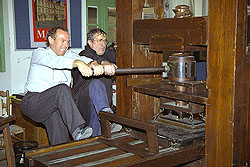 Le Conservateur du Musée Gutenberg de Mayence et Michel Firmin, Maître-imprimeur à Loudun, en plein effort d'impression. |
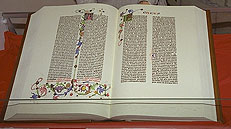 Une copie de la Bible à "42 lignes" imprimée par Gutenberg en 1450 à Mayence (Allemagne) a été offerte par la ville de Mayence (Allemagne) au Musée Théophraste Renaudot de Loudun (France). |
||
| Extrait de la Bible à "42 lignes", cette page de l'Evangile de Saint Jean a été imprimée sur le presse à vis de Gutenberg; seules les enluminures ont été peintes à la main. C'est en 1450 que Gutenberg et ses associés entreprirent cette aventure. Les 30 premiers volumes de cette bible in-folio furent imprimés sur des feuilles de parchemin de 42 cm sur 62. 170 peaux de moutons furent nécessaires pour un volume, et il fallut sacrifier plus de 5.000 moutons pour imprimer 30 volumes. |
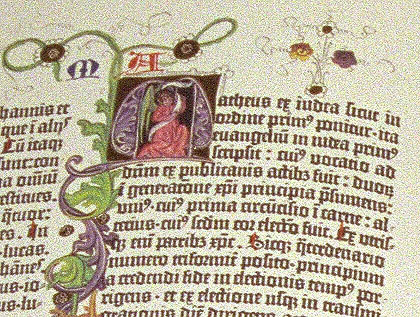 |
||
| JOHANNES GUTENBERG Johannes Gutenberg was born into a noble family of the city of Mainz, Germany. His early training was in goldsmithing. In 1428, he moved to Strasbourg for political reasons, where he remained for over 20 years. It was in Strasbourg that he probably made his first experiments with moveable type. Gutenberg had the idea of utilizing techniques of metalworking, such as casting, punch-cutting, and stamping, for the mass production of books. European books at this time were hand written by scribes in a gothic script with many lourishes and ligatures (interconnected letter pairs). To reproduce this "look," Gutenberg fashioned a font of over 300 characters, far larger than the fonts of today. To make this possible, he invented the variable-width mold, and perfected the blend of lead, antimony, and tin used by type foundries up to the present century. |
Gutenberg developed his press by combining features of existing technologies: textile, papermaking and wine presses. Perhaps his most significant innovation, however, was the efficient molding and casting of movable metal type. Each letter was carved into the end of a steel punch which was then hammered into a copper blank. The copper impression was inserted into a mold and a molten alloy made of lead, antimony and bismuth was poured in. The alloy cooled quickly and the resulting reverse image of the letter attached to a lead base could be handled in minutes. The width of the lead base varied according to the letter's size (for example, the base of an "i" would not be nearly as wide as the base of a "w"). |
e-mail: jc@presscom.com
We are photojournalists and we sell photos, TV and text features as a resource for online and off line magazine publishers.
